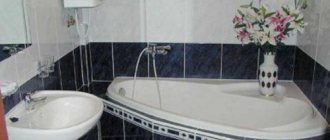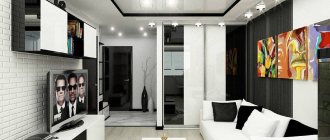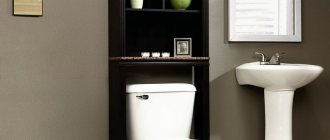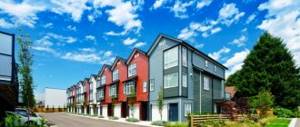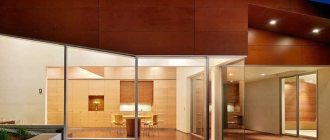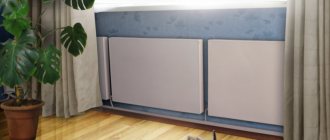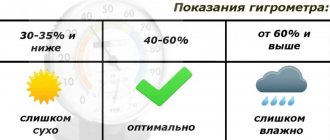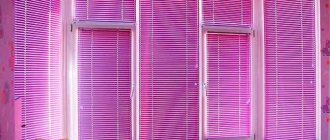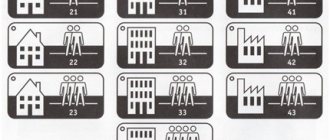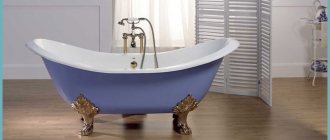Houses with an attic in the French style
The attic got its name in honor of the French architect Francois Mansarou, who in the 17th century was the first to propose the use of under-roof space for living rooms. Therefore, the mansard roof is associated with the architecture of French houses - provincial cottages, Mediterranean chateaus and Alpine chalets. It is interesting that different regions of France have their own special forms of mansard roofs, and both the approach to design and the materials used differ.
Photo: thingsthatinspire.net
Homes in Normandy are as architecturally austere as the climate of this region of France, but the gabled mansard roofs with half-timbered gables and dormers add a touch of French sophistication to their design.
Photo: movoto.com
An interesting roof with a complex configuration, an attic above the garage, a large mass of glazing - modern Norman houses are beautiful and functional at the same time.
Photo: homeplans.com
Unlike the stone architecture of Normandy, Alpine chalets are built of wood, and their gable roof with an attic is usually complemented not only by a window, but also by a balcony.
Photo: dom-chalet.ru
The interior space of the attic under the chalet roof looks very colorful due to the visible rafters and plank cladding.
Photo: alpineguru.com
A characteristic feature of the attic roofs of alpine houses is long slopes that facilitate snow melting, large windows and fairly spacious balconies.
Photo: homeplans.com
In the Mediterranean provinces of France, compact chateaus usually have a multi-gable roof with several attics.
Photo: homeplans.com
French houses with a mansard roof are usually one-story buildings, “flattened” outwards rather than upwards. With a small area of the house, a garage with an attic is usually provided.
Victorian houses with attics
England is another European country besides France in which the construction of houses with attics has acquired an unprecedented scale. Despite their apparent stiffness, English cottages look very cozy, and this effect is achieved to a greater extent thanks to the beautiful design of mansard roofs with windows.
A characteristic feature of Victorian attic houses is the asymmetrical and slightly curved roof line at the gable, as well as large dormer windows.
Photo: houzbuzz.com
Often the British arrange an exit from the attic to a balcony, which utilizes the under-roof space of the terrace roof.
A nice flavor to provincial English houses is given by the color scheme of the facade decoration and wooden shutters of a contrasting color on the attic windows.
Photo: houzbuzz.com
Photo: houzz.ru
Photo: houzbuzz.com
A distinctive feature of English houses with an attic is the large slope of the roof slopes and several asymmetrically located gables. The unusualness of this architecture is enhanced by the blue color of the facade decoration in combination with the gray roofing.
A modern interpretation of Victorian architecture - a house with a hip roof and an attic with small balconies.
Hip roof
A hip roof consists of two trapezoidal and two triangular slopes (hips).
The half-hip design differs in the size of the side slopes. Their upper part is “cut off”, and small pediments are installed instead.
The hip roof consists of four identical triangular slopes that converge at one point. Such structures are suitable for warm climate zones; due to the complexity of design and installation, they are quite rare.
Advantages of a hipped roof
- Original designs, aesthetic appearance.
- High resistance to weathering, snow and wind loads.
- Uniform heating by solar rays, thanks to which a comfortable temperature is maintained in the under-roof space.
- Functional and well-lit attic.
Disadvantages of a hipped roof
- Difficulties in the development and implementation of the project - it is necessary to attract professionals.
- Increased weight of the structure, which requires additional reinforcement of the walls.
- The need for high-quality insulation (in cold regions).
- Increased consumption of roofing materials.
Buildings with hipped roofs look respectable and stylish. They are good on their own - without the use of additional architectural elements.
New trends in the construction of houses with an attic
Despite the established traditions in the construction of houses with attics, architects are always in search of fresh ideas. New technologies and structural materials greatly expand the capabilities of designers and make it possible to implement the most daring and even daring concepts.
Photo: museum-design.ru
An extremely modern trend in construction that came to us from Denmark is attic houses with a hipped roof, lined with the same material as the facades. Moreover, the color of the finish should be as close as possible to black - the color that best absorbs heat.
Photo: houzbuzz.com
Another trend from the Nordic countries is a cottage, consisting of several residential volumes in the form of small houses with attics.
Photo: houzbuzz.com
Not only in Europe, but also in other countries, the popularity of cottages lined with one material, without the use of special roofing coverings, is growing.
Photo: house-minimalist-design-plans.blogspot.com
Such houses usually have a small area, so the issue of using the under-roof space and arranging an attic with windows is relevant.
Photo: houzbuzz.com
A fashionable trend in European architecture is compact private houses with an attic under a pitched roof. In the photo you see how interesting this option is played out with the help of a dynamic roof line.
Building a minimalist cottage under a pitched attic roof is one of the cost-effective options for arranging private housing.
Photo: house-minimalist-design-plans.blogspot.com
A large number of windows give this modern cottage with a pitched roof an unusual look, but the main thing is the maximum use of the usable area of the attic space.
Photo: houzbuzz.com
Western architects offer many unusual solutions, one of them is a private house with an asymmetrical gable roof and an attic.
An effective element of the architecture of a country house with a sloping mansard roof will be the continuous glazing of the pediment and the arrangement of the balcony.
Photo: houzbuzz.com
Numerous projects of wooden country and country houses with a large mass of glazing and an attic are another attempt by architects to make housing more eco-friendly and comfortable.
Photo: houzbuzz.com
The fully glazed facade of the house with a mansard roof is a bold attempt by German architects to create housing that is as harmonious as possible with the environment.
The desire to make a home energy-saving and environmentally friendly is giving rise to an increasing number of projects with attic roofs equipped with solar panels.
General principles of the device
Any building structure consists of a skeleton and a shell. Roofing or rafter systems are no exception. The comfortable and safe living of homeowners, as well as the period of trouble-free operation, depend on their strength and performance characteristics.
The skeleton of a gable mansard roof is a wooden rafter structure. It must meet several basic requirements:
- Strength. Withstand the weight of snow and water, as well as wind and other types of dynamic loads.
- Ease. The lighter the frame, the lower the cost of the entire house.
- Functionality. The rafters should evenly distribute the load on the load-bearing elements without overloading individual areas.
The covering of a gable roof is a shell that protects the interior from heat, cold, moisture, snow and wind. It must meet several basic requirements:
Ease. The lower the weight of the roofing, the lower the load on the rafter system. The final cost of the entire structure depends on this. Reliability. Roofing is the first and main line in the path of an aggressive external environment. Aesthetic beauty. The roof is one of the most prominent elements of a building
They pay attention to him first.
The main structural elements of a gable attic roof
- Mauerlat is a rectangular or square wooden beam. It connects load-bearing walls and rafters together, distributing the load along the entire perimeter of the building. The Mauerlat is laid along the walls and secured with anchors or fittings. Rafters are installed on top of it.
- Rafter legs are the basis of the roofing system. The entire burden falls on them. Rafters are made of wooden beams of square or rectangular cross-section. At one end they rest on the Mauerlat, and at the other they are connected to each other. According to the method of fastening, rafter legs can be layered or hanging.
- Ridge beam is a structural element with a square or round cross-section. It is located on top and the upper part of the rafter legs rests on it.
These three elements form the basis of any attic gable roof. From these you can build a simple rafter system. For more complex structures there are a number of additional elements:
- A strut is a beam that supports the rafters and is installed at an angle to them. At the bottom, the strut rests on the floor beam.
- A stand is a beam that serves to support the rafter leg. It is installed at right angles to the ceiling.
- A scrum is a beam that connects two vertical load-bearing elements. Its main function is to absorb tensile forces in large rafter systems.
- A crossbar is a beam that additionally connects the rafters together. He doesn't let them leave.
- The sheathing is a beam that serves as the basis for installing the roofing. It is made from boards and fastened with a certain step across the rafters.
The quantity and frequency of installation of these elements depend on the design load on the attic gable roof. We must remember - the more elements, the more expensive and heavier the entire structure. The less space will be left for the attic living space. Therefore, before building, you need to carefully calculate everything, and it is better to make a full-fledged one with all the calculations.
Beautiful mansard roofs made of reeds
The surge of interest in environmentally friendly materials has played a role in the revival of the popularity of reed and thatched roofs in European countries. The most important arguments in favor of reed roofs were their excellent ability to retain precipitation and maintain warmth, naturalness and original appearance.
Photo: danmardomy.pl
Natural beige and smoky shades of reed roofs look unusual, but at the same time they naturally blend into the color scheme of the landscape design and organically complement it.
Photo: danmardomy.pl
Half-timbered houses with an attic under a roof made of natural material are a traditional type of buildings in Northern Europe.
Photo: dizainall.com
The reed roofs with an attic and round dormer windows, as if “grown” from the thickness of the roof covering, are unusually beautiful.
Photo: dizainall.com
Creating an attic roof from reeds is a unique art - in the photo you can see how delicately the decor of the attic dormer window is carved.
Photo: dizainall.com
The plasticity of reed stems allows you to create roofs of complex shapes, especially if the house has an attic floor with several rooms.
Photo: dizainall.com
Reed and reed are ideal materials for forming rounded roofs. Such a mushroom-shaped roof with miniature attic windows will become a colorful element of the architecture of a private house made of timber or logs.
Photo: dizainall.com
Only houses of provincial architecture are perfectly combined with a reed roof; cottages of modern design can also be successfully equipped with such a roof. In the photo you see a non-trivial solution - the roof covering goes from the roof to the facades of the building, due to which the house looks more comfortable and, importantly, warmer.
Photo: dizainall.com
The undeniable “advantages” of reed roofs include their ability to maintain a stable temperature inside the house both in hot and cold weather and at the same time provide sufficient ventilation in the attic and other rooms. A significant “minus” of reed roofing is its high flammability, but modern fire-retardant impregnations can improve its fire-fighting properties. In addition, the arrangement of such a roof will cost a considerable amount.
Differences between the two types of roofs
As noted earlier, there are two differences, the aesthetic external perception of the house, but this point is subjective, as they say, taste and color. Another significant difference is the usable area of the second floor.
With a gable roof, the area seems to form a triangle, the walls from the floor go up 1.2-1.4 m and then narrow into a cone towards the top, narrowing the volume of the room.
The space inside the second floor with a gable roof type
With a sloping roof, the walls are even from floor to ceiling, forming an even square (rectangle). This allows a person to stand at full height close to the walls, to place closets and other furniture right next to each other; for some customers, this is important.
The space inside the second floor with a sloping (mansard) roof type
As an epilogue
With any type of roof, the floor area of the second floor remains unchanged. The construction technology, the pitch of the rafters, their cross-section do not change. Each type of roof is suitable for its own home, a gable roof is ideal for one-and-a-half and two-story houses, a broken roof is for country houses. There is one more nuance, since in a sloping roof we get a break on the slope; this place is the most vulnerable and requires qualified builders, since in winter there is some probability of snow blowing in. But with proper roofing work, including wind- and moisture-proof film under the roof, this is excluded. Now you understand the differences between the two popular types of roofing.
Related article: How to make a hip roof with your own hands
In any case, trust the construction of your house to professionals.
Country cottages with mansard roofs from Ondulin
Unlike tiles, flexible roofing and natural coverings, Ondulin roofs are distinguished by an affordable price with a fairly high safety margin. Europeans have long appreciated the practicality of Euro slate and are actively using it for arranging mansard-type roofs.
Photo: danmardomy.pl
A palette of natural colors, as close as possible to natural shades, allows you to organically fit a country house into any landscape.
Hip roofs from Ondulin harmoniously emphasize the architectural features of a house in any style, including classical.
If there is a high wind load in your region, a hipped mansard roof coated with Ondulin will be optimal.
Advantages and disadvantages of mansard roofs
The widespread use of attics does not at all indicate that they have absolutely no shortcomings that could cause the abandonment of an attic roof. But there are also undoubted advantages that may outweigh the disadvantages.
Table: pros and cons of attic roofing
| Advantages | Flaws |
| Increases living space at home | For comfortable living requires careful thermal insulation and waterproofing |
| Allows you to complete an existing house without the cost of a foundation | Increases the load on the foundation, and therefore requires careful calculations, the use of lightweight materials, and sometimes strengthening the structure of the house |
| Makes it possible to reduce the building area (relevant for cities and small suburban areas) | Slopes do not allow efficient use of the entire floor area |
| Costs less than building an extension with a separate foundation | Increases roofing costs, including finishing materials, heat insulators, windows |
| Little time is spent on construction work | Preliminary calculations of the roof structure require a professional approach |
| The use of lightweight building materials makes it possible to do the work yourself | There is no attic or its dimensions are significantly reduced |
| Gives the house a spectacular decorative look | If approached incorrectly, a massive attic can disrupt the harmonious proportions of the building |
Experts emphasize that the benefits of attics only appear if the rules are followed:
- rafter/slope angle from 30 to 60°;
- the height of the room at the top point is from 2.25 m;
- the height of the room at the lowest point is from 1.5 m;
- attic width from 3 m.
It is inconvenient to use tighter spaces, and as the attic increases, the structure becomes heavy and additional supports are required inside the room.
Video: comparison of an attic roof with a cold attic
Types of attic structures
The type of object depends on the capabilities and needs of the developer. Today, designers distinguish two types of premises: single-level and two-level.
The first attics are of three types:
- Mansard roof under a gable roof. The convenient location of the slopes does not delay precipitation, the installation of a warm attic does not require lengthy calculations, because such options are considered the simplest, most practical and reliable.
- An attic room under a sloping roof. A little more complicated in design, the room has an increased volume of living space and looks very original.
- House with an attic with remote consoles. This option is the most difficult to implement, but at the same time a large living space appears in the attic. The offset of the roof, forming a canopy, is used to arrange a veranda and garage.
A two-level attic design is essentially two rooms that are located on different levels. The convenience of the form is beyond doubt, but supports of a mixed type are needed.
In addition to being divided according to general characteristics, types of mansard roofs are divided by shape, type, and even country. The fact is that residential under-roof space has existed for more than one century, but this type of housing came to us much later than it appeared in Europe and other countries. Wooden huts and towers either had a full second or third floor, or a cold attic. Look at the photos of mansard roofs of different variations, perhaps this will help you in deciding the shape of your house.
Norman or French style
France can be considered the “ancestor” of the attic; the room was named after the architect François Monsarou, who was the first to apply the principle of arranging an under-roof room in the 17th century. The mansard roofs of private houses, photos of which are presented, have undoubted advantages and vary in style. The use of well-selected materials and a harmonious combination of design colors gives such buildings a unique charm.
Fact! French roofs of houses with an attic, photos of which are presented, are, as a rule, one-story buildings, slightly increased in area, but not in height. In this case, the practice is to place a living room under a roof above the garage, which allows you to use more space with a small footprint.
The harsh climatic features of the northern regions of the country are reflected in half-timbered houses. The attics here are equipped with dormer windows, pediments and, despite all the severity, look perfect.
And here is the “garage” version of the attic
– a little more calm and gentle. Add glazing and the result will be functional, aesthetically pleasing, moderately subtle and unusual. The roof of a complex shape complements the French chic, but will fit quite organically into our open spaces.
Alpine chalets are a separate matter. Here the gable wooden roofs are complemented not only by large windows, but also by a balcony. The interior decoration looks especially elegant if the wooden elements are not covered with cladding. A characteristic feature of the chalet is the elongated slopes, which can be explained by the snow cover. At the same time, the warmth of enlarged window openings and spacious balconies allow you to enjoy the warmth of the Alpine mountain summer.
Mediterranean motifs dictate the design of the roof of the house. In this case, there is a limited form, a certain compactness. It looks best in combination with a multi-gable form and not one, but two or three attics. Of course, such a do-it-yourself attic is not accessible to every craftsman, but the work will pay off with interest: in a small area you get two or more full-fledged additional warm rooms.
Old English classics
This country can challenge the primacy of housing under the very roof. The stiffness of the classics does not in the least prevent the cottages from looking more than charming, and the honor of imparting comfortable living and aesthetics belongs to the mansard roofs. They smooth out the severity of the lines and provide enough light thanks to the large windows.
Characteristic features of this form of roofs can be considered slightly curved lines of roofs on the gables and asymmetry of the elements.
And, of course, you should carefully choose the shades of the cladding: the windows must contrast with the general background, otherwise you will not achieve “Old English chic”.
Fact! If you want to maintain English aesthetics, when designing, you should include an increased slope of the slopes and asymmetry of the pediments. New chic - an interpretation of the Victorian hip roof.
Attic with many small balconies. The design will require additional expenses, but the house will definitely look original, and you will be able to enjoy the views of rural spaces.
Types and variations of mansard roofs
In private construction, in addition to the already mentioned gable sloping roof, single-pitch, hip, gable, and vaulted varieties are used. But unlike the first option, the wall of a house with such a roof is made a little higher so that the slope begins 1.5 m above the floor level.
An attic can be installed under any of the pitched roofs
Construction technologies make it possible to equip an attic under any roof, but it is important to understand that the efficiency of using space will be different. For example, a multi-gable or diamond roof will require a lot of time and effort for insulation and will complicate waterproofing. And properly arranging the resulting complex polygonal space is a real art, because in the absence of straight walls and a hint of a flat ceiling, most people feel uncomfortable.
At the same time, a hip or vaulted roof allows you to create a familiar space under the ridge, and cut off areas that are too low for a person with the facades of built-in wardrobes. In addition, a roof of simple design is significantly cheaper when insulated.
Therefore, if you are planning an attic, try to think in advance not only about the appearance of the house, but also about the convenience of the resulting attic.
Single-pitch
In our region, pitched roofs are most often found on various extensions and utility buildings. But in warmer countries, pitched and flat roofs are very common, so for a house with modern Western architecture, such a roof would be very appropriate.
A pitched roof is not necessarily a simple structure; it can consist of several fragments
It is better to plan an attic in a house with a pitched roof in advance, so that during the construction stage of the house, raise the lower point of the slope at least 1 m above the ceiling. If an attic was originally planned for the house, when arranging the room, you will have to cut off a significant part of the area near the slope and under the ceiling in order to visually align the geometry of the room.
Among the advantages of a pitched mansard roof:
- minimum cost of work and materials;
- the ability to carry out calculations on your own (on the Internet you can even find online calculators for choosing the angle of roof inclination);
- the use of ordinary windows in the end wall and on the gables for maximum natural light in the attic (expensive attic windows are simply not needed);
- the ability to create a two-level attic with a sleeping area under the ridge (the height difference in the room allows for at least partial overlap).
The rafter system of a pitched roof varies significantly depending on the width of the building
Explanations for the diagram:
- Rafter leg.
- Rack.
- Strut.
- Rafter beam.
- Rigel.
- Spacer.
- Upper run.
- Sill.
The wider the planned building, the more complex the truss system of a pitched roof should be. If the width is more than 8 m, it will be impossible to arrange open free space in the attic; you will have to divide it into rooms.
If you enclose the space under the upper corner of a pitched roof, the room looks more harmonious
An attic under a pitched roof is not the best solution in terms of using space and saving money. For example, it will not be possible to reduce the amount of wall building materials due to the fact that one of the walls will inevitably turn out to be much higher than in the case of building a second floor. Therefore, a lean-to attic is a good solution in terms of facade design, but a comfortable room under the roof will cost almost the same as a full second floor .
Gable
A roof consisting of two slopes with triangular gables is the most common option for all types of buildings, both with and without attics.
A gable mansard roof without built-in windows does not necessarily look primitive
Advantages of a gable mansard roof:
- simple design that can be calculated independently;
- low material consumption, no need for expensive valleys, additional skates, connecting elements;
- ease of performing work on hydro-, steam- and thermal insulation;
- the ability to install ordinary windows in the pediment wall, and they are much cheaper than attic windows (if the house is small, you can make the pediment completely translucent);
- savings when maintaining the roof (snow easily comes off smooth slopes, with a minimum of joints the likelihood of leaks is reduced, repairs and cleaning can be done independently).
A gable roof looks rather modest, so such houses are often decorated with additional dormer windows, “birdhouses” (a wall projection with a vertical window), and balconies along the gables.
The greater the distance from the interfloor ceiling to the bottom point of the slope, the steeper the roof angle can be made.
A simple gable roof allows you to equip a small attic
The space under the roof can be used as efficiently as possible only when the wall is initially made 1–1.8 m higher than the level of the interfloor ceiling. If the attic is converted from an attic, the internal corners along the ridge have to be sewn up or this space must be used for storage. When the slope is completely open, a feeling of oppressive ceiling is created, which is difficult to eliminate using design techniques. If the height of the ceiling allows, the upper space under the ridge should also be cut off so that the room takes on a more familiar shape to the eye.
Dormer windows located in the slopes and on the pediment make the room brighter and more spacious
When the slope begins at eye level and above, the room is perceived as more spacious and higher. If there weren’t a fairly high vertical wall in the attic, it would have been perceived as a birdhouse and it would have been impossible to sit comfortably on the sofa.
If you want to make a proper gable mansard roof, be sure to increase the wall height by at least 1.5 m.
Broken
A gable roof with broken slopes is the most common type of attic roof. As already mentioned, it was this kind of roof that was originally called attic.
The design of a sloping mansard roof is the most effective and simple
Its advantages:
- the absence of side walls, which allows you to start creating a roof right at the height of the ceiling (saving money, time, reducing the load on the foundation due to the use of light wood instead of brick);
- a slight slope of the slopes, thanks to which the walls of the attic turn out to be almost straight (you can arrange the furniture rationally, there is no feeling of a pressing ceiling);
- the ability to equip a small attic under the ridge to store necessary things;
- the ability to expand the floor area due to the eaves overhang protruding beyond the walls by 1–1.5 m (additional external supports will be required).
If desired, roof windows can be added to the upper or lower part of the roof slopes. In the first case, the light openings will be located almost vertically, which will not only make it possible to rationally use the window sill, but will also reduce the snow load on the double-glazed windows.
A large attic can be made with straight walls, separating the corners
If the house is large (from 8 m), the slopes will need to be reinforced with additional supports indoors. This method helps to create a more wind-resistant and durable roof than simply reinforcing the beams and using laminated veneer lumber for the rafters. This approach leads to an increase in the material consumption of the structure and fragmentation of the internal space. But additional supports can be used as a basis for internal partitions and built-in cabinets, and some of them are often made decorative. Therefore, such a constructive solution will not worsen the aesthetics of the attic.
Thanks to the location of the windows on the slopes, the classic attic looks very avant-garde
A sloping gable roof is the optimal solution for placing an attic above any house. It will help save money and at the same time provide a spectacular appearance to a comfortable attic space.
Hip roof for attic
Roofs that consist of four slopes are called four-slope roofs. In this case, the slopes of a building can be the same, like a hipped roof, or identical in pairs, like a hip and half-hip roof. Houses with roofs of the first two types do not have gables at all, so ordinary windows are not suitable for them. To provide access to natural light and ultraviolet radiation, it is necessary to install skylights, skylights and birdhouses.
Thanks to the “birdhouses” with balconies on the hipped roof, the house with an attic looks like a two-story cottage
In addition, hipped roofs have a complex design, unlike single- and gable roofs. You should approach the calculation of the truss system for a 4-pitched roof carefully and use the services of professional architects or detailed ready-made drawings. Since both hip and hip roofs have many junction points, experienced builders should also construct such structures.
In addition to these disadvantages, hipped roofs are more expensive than double- and single-pitched roofs and require a stronger foundation and reliable walls. Let's look at what advantages of hipped roofs have made them so popular.
hip
The hip (Danish) roof consists of four slopes, two of them triangular and two trapezoidal. A ridge forms at the top of the roof, but it is 1/2 or even 3/4 shorter than the house itself (for a gable roof, the length of the ridge and the roof are the same).
The classic hip roof consists of two triangular and two trapezoidal slopes
Advantages of hip mansard roofs:
- camouflage effect - the house from the facade appears to be a modest one-story building, but inside the living area is much larger;
- the ability to make panoramic glazing with skylights so that the sun's rays enter the room through different slopes and illuminate it well at any time of daylight;
- increased resistance to hurricane winds, since the slopes form a more aerodynamic figure;
- durability, which is ensured by increased structural rigidity.
A hip roof requires better insulation and vapor and waterproofing
The construction of a hip roof is not only more complex than a gable roof, but also requires higher quality materials. If you reduce the requirements for timber or membranes, the entire structure will be at risk. But if everything is done correctly, the roof will be durable and decorative.
The fireplace chimney is successfully hidden in a decorative partition in the attic
If you properly sew up the low part of the attic under the slopes, the resulting space will be smaller than under a gable roof, but much more comfortable. This shape of the ceiling makes it appear higher than it actually is.
A hip mansard roof is a good solution for those who want to “dissolve” the house into the surrounding nature and do not skimp on roofing.
Half-hip
The half-hip (Dutch) roof, like the hip roof described above, has four slopes, but the triangular ones are made not full, but truncated. The result is similar to a bob hairstyle with bangs: trapezoidal slopes end above the ceiling level, triangular slopes open the pediment by 2/3.
In a half-hipped roof it is easy to arrange an additional window under the ridge
A half-hip roof will not help disguise the attic as an ordinary attic. On the contrary, it helps to arrange full-fledged windows of quite large size on the pediment, so the house looks like a two-story one.
As for the price range of a half-hip roof, the amount of savings depends on the materials you choose. If expensive facing bricks are chosen for the construction of gables, careful thermal insulation is carried out, and high-quality double-glazed windows are installed, the price may be no less than in a house with a modest hip roof and one or two dormer windows.
Other advantages of half-hip roofs include:
- two vertical walls in the attic make it possible to arrange standard furniture, there is no need to make it to order;
- half-hip roofing can withstand the strongest winds, thunderstorms and hurricanes;
- The slopes of the Dutch roof are gentle, which gives a pleasant psychological effect and allows you to effectively use the entire area of the room.
Additional rigidity of the half-hip structure is provided by spacer beams
When constructing a rafter system for a half-hip roof, spacer beams are located at the level of the lower part of the triangular slopes, which provide the necessary rigidity of the structure. They can become the basis for the attic ceiling, the ceiling between the attic and the attic, or additional interior decor. Modern designers prefer not to sew up this element in order to make the room visually more spacious and airy.
If your region receives a lot of snow, the angle of the half-hip roof should be at least 60°.
It is best to arrange a space for relaxation under a half-hipped roof so that residents are not disturbed by the low slope
A half-hip mansard roof is the best option for regions with strong winds and light snowfalls . If you live in other climates, consult an experienced architect before installing a Dutch roof.
Tent
A hipped mansard roof is another type of hipped roof. It is distinguished by the same size of all slopes and the absence of a ridge; all slopes converge at one point. When viewed from above, a hip roof looks like a pyramid with a square base.
To make the house more interesting, the architect made the slopes of the hipped roof broken and divided them into fragments
A hipped mansard roof has one important limitation - the house must be square, otherwise the slopes simply cannot be brought together to one point.
Let's consider the advantages of a pyramidal roof:
- good aerodynamics, even better than a half-hip roof;
- simple and inexpensive filing of overhangs, since they are all located strictly on the same level;
- simplified calculation of the structure (compared to hip and half-hip), since all slopes are the same;
- the roof surface is heated from several sides at once, which promotes natural snow removal and rainwater drainage.
A hip roof can only be installed on a square house
In a hip roof, the main load falls on the point where the rafters converge, so in a large house you have to either install a large central support, or distribute the load using a large number of posts under the slopes. Both options interfere with the creation of an attic studio, but allow you to organize a well-zoned space.
Under a large hip roof you can create a round attic
If you are not looking to save money and want to make your attic floor original, choose a hip roof. For example, the interior of the restaurant in the photo became extraordinary precisely thanks to the hipped roof with dormer windows arranged in a circle.
Multi-forceps
A multi-gable roof, in contrast to a hipped roof, has four pediments at once, that is, the attic under such a roof is illuminated by ordinary windows on all sides. When viewed from above, the multi-gable roof looks like an outlandish flower or a product made using the origami technique. Most architects love such structures precisely for their decorative effect, since they are much more complex to manufacture and maintain than other types of roofs. Particular difficulties are caused by the waterproofing of gables (concave planes limited by the ridges of neighboring slopes).
When using one roofing material on a site, buildings with multi-gable, hip and pitched roofs look good
Advantages of a multi-gable roof:
- the lower part of each external wall is straight, this makes it possible to use standard low furniture (slopes and internal corners will interfere with placing high ones);
- vertically standing windows on the gables can be beautifully decorated with classic curtains; you don’t have to limit yourself to roller blinds or Roman blinds with additional lower fastening;
- The inner sides of the tongs support avant-garde and futuristic interior styles well.
When constructing rafters for a multi-gable roof, it is necessary to verify up to 1 mm many connections at acute and obtuse angles
In no case should you design a multi-gable roof yourself; even professionals prefer to adjust and modify the workpieces to avoid miscalculation. At the same time, keep in mind: a roof with so many slopes does not withstand strong winds well, so make sure it is suitable for your region.
A multi-gable roof is not yet a reason to make the attic interior modern
If you want the house to look like a castle and the attic to be well-lit by sunlight, a multi-gable roof is suitable for this. But keep in mind that the roofing will not only look expensive, but will also cost a pretty penny.
Bubnovaya
A diamond roof is sometimes considered a variation of a hipped roof, only all its slopes are diamond-shaped and converge at one point, like a hip roof. This type of roofing is considered optimal for an attic, but is rarely used. Most likely, the reasons for this phenomenon were the complexity of constructing the roof, the need to use especially strong beams for the ribs (they must withstand the loads that are usually placed on the rafters that are missing here) and the high costs of roofing materials with an asymmetrical profile (like the popular metal tiles).
If you make a diamond roof with broken slopes, the attic space can be used even more efficiently
But diamond roofing has undoubted advantages:
- the complete absence of valleys eliminates the possibility of snow bags forming and reduces the risk of leaks by an order of magnitude;
- four gables make it possible to use full-fledged vertically installed windows and beautifully decorate them with curtains;
- due to the shape of the roof, the presence of an attic does not exclude the possibility of organizing an attic, which provides storage space and improves thermal insulation;
- The material consumption of the roof is low (when using roofing material with a symmetrical profile - ondulin, slate, corrugated sheets), so it is cheaper than multi-gable and hipped ones.
Let us remind you that the advantages of a diamond roof are manifested only if professionals were involved in the design and construction.
Even if the gables of the diamond roof are low, the attic turns out to be cozy and comfortable
Professional architects, who are able to independently take into account all the nuances when calculating a diamond roof, build just such a roof over their houses. After all, it is decorative, like a multi-gable roof, wind-resistant, like a tent roof, and durable, like a gable roof.
Mansard roofs of complex shapes
Today, houses of simple design are not popular, because few people want to live in a square or rectangular box. Therefore, the shape of the roof above the house is rarely classical; it is constantly supplemented with protruding elements for windows, additional slopes are made for extensions, and several classic roofs are combined into one. Such roofs, on the one hand, look more interesting, and on the other hand, they help solve problems with lighting, organizing a canopy, saving building materials and other issues.
L-shaped and T-shaped roofs
Roofs of this shape appear when the building has the shape of the letter L or T, or a carport or covered recreation area is planned near the house. A common roof gives the building a more harmonious appearance and avoids unsightly joints and level differences.
The T-shaped roof is characterized by the presence of internal corners
In fact, L- and T-shaped roofs are simplified versions of a multi-gable roof with all its disadvantages and advantages. In particular, such a roof is more expensive due to the need to strengthen and waterproof the valley, as well as due to the large number of cuttings of roofing materials (except for flexible, natural and polymer-sand tiles).
The L-shaped roof on a country house looks very harmonious
If for square or rectangular houses you can choose the roof at your discretion, then L-shaped and T-shaped buildings can only be covered with the same roofs; it is impossible to simplify the design. But if you want to diversify the roof even more, it is quite acceptable to use protrusions for windows, roof windows and other decorations.
Mansard roofs with additional slope
Most often, an additional slope in the roof appears when an extension is made to the house. Its roof can become a continuation of one of the existing slopes or be a separate single-pitch structure. As a rule, an additional slope does not affect the configuration of the attic in any way; it only requires additional calculations for the correct placement of rafters and sheathing.
An extraordinary roof makes a small house look like an ancient castle
A competent architect is able to design a mansard roof with any number of slopes. But such an exclusive is unreasonably expensive and usually does not add useful space to the attic.
An additional slope forms a visor
One of the justified options for a roof with an additional slope is the organization of a canopy over a bay window or porch. This complicates the roof structure, but it looks much more harmonious than a regular canopy.
The non-standard configuration of the attic ceiling can not be hidden, but emphasized with the same graphic chandeliers, tables and columns
Dome mansard roofs
The roof of a house in the form of a hemisphere or a multifaceted pyramid is the most original type of mansard roof. The main advantage of such a roof is its decorative effect. Its ability to withstand snow and wind loads, savings in building materials and the absence of snow pockets fade into the background, because the most ordinary gable roof has such advantages.
Selecting dormer windows for a domed roof is an extremely difficult task
With the help of a competent architect, you can create a truly original house with a domed attic, and it will cost less than a multi-gable roof.
The domed roof of the attic creates a truly fantastic environment
New trends in attic space
Leaving aside all historical motives, architects offer a completely new design for houses with a residential roof. The construction principles of the northern peoples were taken as a basis, where harsh conditions forced the under-roof space to be built as warmly as possible. For example, an ultra-modern option: a hipped roof with cladding made of the same material as the facade.
The roof of the house with an attic, the photo of which is presented, is made in dark colors - this is a tribute to the frost: the sun warms up such a roof faster, which means the house will be warm.
For those who are building two houses, a suitable option is in the form of several residential volumes connected by one roof. It turns out 2-3 houses with attics - quite comfortable small-format housing.
Panoramic windows, the right selection of materials and the end result is stylish and comfortable housing of sufficient space. Small-format houses with a roof without finishing with roofing materials are another modern option. The projects provide for limited space, so the issue of housing under a roof is especially relevant.
Windows in the attic provide sufficient warmth and lighting.
As for pitched roofs, contrary to the opinion of domestic builders, they can also be very convenient for placing living rooms. Despite its minimalism, the option is distinguished not only by its economic benefits, but also by its variety of options. For example, a curved roof for an attic with windows looks very attractive.
The types of roofs in a private house are endless. For example, in order not to add serious loads to an old house, a glazed “living roof” built using the lightest materials is suitable.
Such solutions and designs are good for small houses and for houses built from foam concrete and other lightweight materials. And if you want not only practicality, but also an incredibly futuristic structure, you should choose a glazed and maximally open design.
A solid glazed pediment, a luxurious balcony - such a country mansion not only fits perfectly into the landscape, but also allows you to literally “not feel the walls.” An option with an asymmetrical arrangement of gable roof slopes and an attic with a balcony is another eco-design.
And for those who love unusual shapes, a remote attic, slightly overhanging the main building, is suitable. In addition to being spectacular, this design allows you to make maximum use of the attic space, obtaining a spacious “second floor”, and also creates a good canopy for the veranda.
The various types of roofs of private houses make you think about your choice. The convenience of a warm attic is also that, if there is sufficient space, the room can be equipped even if the buildings are already dilapidated. You just need to correctly calculate the possible load, choose lighter flooring options, renew the roof and insulate the attic - the finished room will become cozy, homely, just put in a little effort and imagination.
Briefly about a gable roof for a house with an attic and photos of finished projects
As already mentioned, such a roofing system is the most accessible to manufacture in an extremely short time. The main design elements are :
Traditionally, wooden beams are used here; an option with metal products is also possible, but it has such disadvantages as heavy weight and high price. According to housing construction standards, lumber must be treated with solutions that provide protection against fire and fungus.
Comparing all types of roofs for country houses with an attic, a gable roof will be the most optimal solution. Typically, such a roof is made equilateral with slope angles ranging from 25-50°. Of course, it is possible to make one slope larger than the other, but when calculating, you should take into account the distribution of the load on the walls and make it uniform.
Designers note the following advantages of a roof with two slopes :
- simplicity of design;
- affordable price of materials;
- possibility of self-installation;
- efficient drainage of rainwater.
When installing roof insulation, be sure to provide space for ventilation - this will prevent condensation and extend the life of the insulation.
Mansard roofs: types and design features
Surely, sooner or later, every owner of a private house comes up with the idea of arranging an attic roof - the so-called attic. It allows you to expand the space of the building, thereby preserving the treasured meters of the site itself. In addition, if you show a little imagination when building and decorating this part of the house, then the non-standard and attractive appearance will delight not only guests, but also ordinary passers-by. You can learn how to correctly combine all construction safety requirements and an individual design concept from this article.
What it is?
Many people associate the image of an attic with the bohemian creative life of Paris, whose representatives - writers, musicians and artists - lived on the highest, dimly lit and unheated floors. In the literal sense, these were utility premises that only the poor could afford.
Today, the presence and design of an attic roof speaks of the owner’s wealth and sense of taste. The architectural geometry of the roof, unusual combinations of window openings and balconies will not only distinguish a private house from others, but will also functionally increase the living space, eliminating the cost of another floor.
The room can also affect the reduction of heat loss in the building. Officially, according to all standards, the attic must have a height of at least 2.5 m from the floor level, otherwise it will be considered an attic.
When building an attic roof in Russian conditions, one should remember the peculiarities of natural conditions - rather frosty winters with frequent temperature changes require special attention to the quality of insulation of the attic room.
How much does it cost to build an attic
The construction of an attic floor is considered profitable due to the fact that there is no need to spend money on erecting walls. This is only partly true.
Firstly, a lot of money will be spent on creating a rafter system. Its cost depends on the type of mansard roof chosen (see below) and on the price of lumber in your region.
Secondly, you will have to spend a considerable amount on insulation and vapor barrier of the attic roof. It is clear that roofing material alone is far from sufficient to ensure the required air conditions for residential premises (if the attic is planned for residential use). It will be necessary to insulate, and the layer of insulation should be significant. For example, for central Russia, the layer of high-density mineral wool should be from 200 mm, plus a layer of waterproofing and vapor barrier.
Thirdly, windows are much more expensive. If you make them auditory, you build a special structure from rafters, which complicates the roof topography, and therefore increases the cost of materials and installation. Even on an ordinary gable roof you have to think about constructing valleys and retaining snow above the windows.
Installation of skylights in the roof
The second option - windows in the roof plane - require particularly careful sealing so that precipitation cannot get inside. This makes installation 1.5-2 times more expensive. The windows themselves cost about the same amount: they must have a reinforced frame and reinforced glass that can withstand snow loads. In addition, for maintenance the frame must be rotary, and this further increases the cost.
What is needed to install a roof window and the procedure for installing the components
There are two types of windows in the attic - vertical and in the plane of the roof. Both types can be used in the same project. The photo below is a good example of such a combination. You can’t really say that the house is unmemorable. How many more options could there be?
Attic roofing in several levels is also a common technique
In addition, such popular and inexpensive roofing coverings - metal-based materials such as corrugated sheets, metal tiles, roofing iron - are not recommended to be used when installing the attic roof of a private house. There are two reasons:
- High thermal conductivity. Due to the fact that metal conducts heat very well, it is necessary to lay a large thickness of thermal insulation materials. Otherwise, the attic will be too hot in the summer and cold in the winter.
- Increased noise level created by the coating during rain. Even an ordinary roof covered with metal sounds like a drum when it rains. The attic room is much larger in area and the “tool” is more powerful. If you can combat the noise level indoors with additional sound insulation, then you can’t do anything to reduce the sound outside. If the neighbors' houses are located at a considerable distance, this may not be a problem, but if the buildings are dense, conflicts may arise.
Related article: How to assemble and disassemble an interior door
If you do the math, additional thermal insulation and sound insulation will minimize the cost savings when purchasing roofing material. Perhaps another, initially more expensive roofing covering will turn out to be more profitable as a result. So here you need to calculate your options.
All this was described so that you have a more complete idea of whether building an attic floor is really that cheap. It turns out - not very good. Nevertheless, this solution has its advantages:
- The attic floor turns out to be light. Therefore, the foundation for private houses will require only a little more powerful than when constructing one floor. Since the cost of the foundation is a significant part of the cost, the gain here is tangible.
- If there is a shortage of funds, insulating the attic and putting it into operation can be delayed for the required period. Moreover, this delay will be useful. That's why. During construction, wood with high humidity is almost always used. If you start insulation right away, moisture will be absorbed into the insulation. If the “pie” is done correctly, it will go away naturally. But if there are violations, problems may arise. If the roof under the roofing material stands for some time without insulation (but with waterproofing installed under the roofing), then the wood will dry well and there will be fewer problems.
- The attic allows you to make your house original and non-standard. In any case, the building turns out to be more expressive and individual - there are a lot of design options.
We tried to describe as fully as possible the disadvantages of a mansard roof and its advantages. If the difficulties do not frighten you, choose which design you prefer.
Read how to make a gable roof here.
Device Features
The design features of the attic require adherence to certain rules:
- soundproof;
- reliable insulation and vapor barrier;
- no stretch marks or bevels;
- ventilation gap;
- functional and aesthetic combination with the overall exterior of the house.
At the same time, compliance with all the rules does not limit the choice of various designs of the structure itself: single-pitched, gable, broken, two-level, conical roofs, with or without a balcony, mid-turn or balcony dormer windows. There are many variations. For reliability and safety, it is important to choose the type of roof, calculate the dimensions, and the amount of insulation and roofing materials.
Comfortable living in the attic directly depends on thermal insulation , which will allow you to enjoy slight coolness in the summer and retain heat in the winter. Let's consider the method of laying the “pie” of the attic roof, which will serve not only as insulation and the base of the roof, but also as protection from the All surfaces inside the attic floor - the ceiling, floor and walls - must be insulated. It is important to first draw up a plan for the attic with all communications and an indication of the thermal conductivity of the materials from which the building and load-bearing coverings are constructed. Only after this is the selection and calculation of insulation made.
Particular attention should be paid to the indispensable presence and exact sequence of each layer of the attic insulation “pie”:
- vapor barrier layer;
- insulation;
- ventilation gap;
- waterproofing material;
- roofing covering.
In this list, a layer of insulation and ventilation are especially important. The following materials can be used as insulation.
A modern, sought-after material with low density but high strength. It is soundproof, does not corrode and does not attract dust. However, a significant drawback is the high flammability and release of toxic substances. If we choose this insulation, then the foam layer must be protected by at least 3 cm of a fire-resistant structure, for example, two-layer plasterboard. In addition, polystyrene foam is susceptible to rodent influence.
Mineral wool
The most common material for attic insulation. Among its characteristic features are resistance to temperature changes, fire safety, high sound and heat insulation, and harmlessness from an environmental point of view. You can purchase it in the form of a roll, slab or mat. The latter is recommended as attic insulation. The material definitely needs good ventilation.
Polyurethane foam
The main advantages are strength, long-term use, not susceptible to moisture, mold, suitable for any surface, non-toxic. But all the advantages hide the high cost and the work of exclusively specialists with the equipment.
It must be remembered that the thickness of the insulation layer is determined depending on the climate zone.
To insulate the attic you will need:
- waterproofing film;
- insulation material;
- vapor barrier;
- mounting tape;
- cord (nylon);
- nails;
- hammer;
- pliers;
- sharp knife.
Thermal insulation of a room is directly related to the quality, type and size of roof windows; their structures are usually placed between the roof rafters in order to avoid expensive reconstructions. Therefore, when choosing, it is important to focus on the available dimensions. Among other things, you need to take into account the height of the slopes, the total area and purpose of the room.
The standard sizes of dormer windows are considered to be 78x118, 78x140, 78x160 cm and larger sizes - 94x140, 114x118 and 114x140 cm.
If the rafters are set closer than the established frame standards, it will likely be necessary to have the window made to order, which will of course have an impact on costs.
According to the method of opening, roof windows are divided into:
- mid-rotation structures;
- with side axis;
- raised axis of rotation;
- with lower axis;
- a combined axis that allows you to rotate the sash 180º.
The most popular option among Russian summer residents is with a central axis of rotation. The advantages are ease of use (such windows are easy to clean).
A separate variety is represented by remote-controlled windows, which will be convenient if the location does not allow you to reach them yourself. They are often equipped with rain sensors.
Depending on the model, several types of windows can be distinguished.
- Vertical. They are mounted in a special so-called attic “birdhouse”, which is why you have to slightly change the roof structure. However, they guarantee a large amount of light.
- Balcony attics. They are two doors, when opened, one rises, the lower one moves forward, forming a miniature parapet. Just like the previous model, they require high costs.
It should be noted that, if load-bearing walls are possible, you can also make a hanging balcony, which can be located either on columns that serve as a decoration in front of the entrance, or you can move the pediment (part of the end wall between the roof slopes and the eaves) of the attic floor from the load-bearing wall, and the roof of the ledge done by extending the roof to the level of the outer wall.
- Extensions. Decorative window top elements. They fit perfectly into the design and most often have a round, semicircular or triangular shape.
- Light tunnel. It combines a reflective tunnel into the room and a lampshade directly in the room itself, which evenly diffuses the light.
- Cornice models. They are located at right angles in the gap between the wall and the roof.
- Glazed bay window. Quite an exotic and expensive glazing model. The structure extends beyond the plane of the wall.
Leading Russian manufacturers of high-quality roof windows are Velux, Fakro, Roto. Velux models are slightly more expensive. For example, a window measuring 78 cm will cost 21-24 thousand rubles, a wider window will cost from 26 thousand.
Also, don’t forget about some additional useful accessories:
- blackout curtains;
- roller shutters, blinds;
- heat-absorbing mesh;
- mosquito nets.
According to established standards, the glazed area must be at least 10% of the floor area.
How to calculate a mansard roof
The design of a mansard roof compared to a conventional one is distinguished by the presence of many additional elements, for example, exits to the roof or roof windows. Quite often, attic projects also include balconies or terraces. All this, naturally, somewhat complicates the rafter system of the structure, and at the same time its calculation.
An attic roof is erected not only during the construction of a house, it can also be the reconstruction of a non-residential attic into a residential heated room, and then its size and area can be greatly limited. All this is taken into account when choosing and calculating the rafter system. In addition to rafters, the supporting system usually includes racks, crossbars, struts, and hangers, and for each of them it is necessary to correctly calculate the cross-section.
Calculation of roof area
The next step is to calculate the area of the roof itself. The simplest options are single- and gable roofs. To calculate the area, use elementary formulas from the school geometry course: multiply the length and width of the slope. For a single-slope building this will be the desired value, and for a double-sloping one the resulting values are added up.
Let's take a more complex, broken surface as an example. To calculate the area, it is conditionally divided into separate elementary geometric figures, the area of each of them is calculated and the results are added up.
The plan of the attic roof will help to isolate the figures required for the calculation
How to calculate the roof slope without errors
How to build an attic roof so that it is comfortable and warm, but at the same time safe, resistant to various influences, and within a budget that suits your capabilities? When constructing an attic, it is necessary to take into account all the requirements as a whole, since they are, to one degree or another, interrelated. Eg,
- with a large angle of inclination, the load on the rafter system is greatly reduced. This is on the one hand, but on the other hand, the usable area of the attic is reduced, and material costs increase significantly;
- An excessively small slope increases the climatic loads experienced by the roof, so the calculation is carried out taking into account increased strength. At the same time, the weight of the structure increases, due to which the load on the foundation increases significantly.
The relationship between the angle of inclination and the rafter system
When calculating the angle of inclination, the following factors are taken into account:
- climatic conditions, in particular, the level of precipitation in a given area, maximum wind and snow loads;
- architectural solution;
- design features of the house and attic;
- roofing material.
for a gable roof, a slope of 45 degrees is considered optimal, and for a sloping roof - 60 for the lower and 30 for the upper slopes, respectively. With these parameters and a well-thought-out interior, you can get a room convenient for living.
Formulas for calculating the angle of inclination of a hip roof
To individually calculate the slope, knowledge of the basics of geometry is sufficient. When viewed from the side of the gables, the roof most often has a triangular shape. Having the height and base values, you can easily calculate the length of the side and the size of the adjacent angle. In the calculations, Bradis tables are used, which allow the angle itself to be found by the tangent value.
Advantages and disadvantages
The advantages of the attic floor can rightfully be considered:
- Economical. The attic allows you to reduce the cost of heating the room. The air space between the floor and ceiling of the attic prevents generated heat from escaping through the roof. The low thermal conductivity of air allows more heat to be stored on the ground floor.
- Savings on adding another floor or increasing living space by expanding the foundation are also obvious. The attic allows you to get constructive additional space at minimal cost.
- Aesthetic appeal. Undoubtedly, the attic, with its complexity and expressiveness of the roof, gives the building a harmonious, architectural and complete look.
- Construction speed. Such an extension will not last for several years, as often happens with the expansion of the foundation. Installation can be completed within a week.
Hip roof
The hip roof consists of four planes, which are located at an angle. This roofing is considered one of the varieties of a hipped roof.
Hip roof diagram
Not subject to deformation in places of eaves canopies;
Original appearance;
Can withstand strong winds;
Possibility to equip an attic or attic;
It protects the façade well from precipitation, thanks to the installation of additional overhangs.
Photo of a house with a hip roof
The disadvantage of a hip roof is:
The complexity of its installation, the complexity of laying roofing materials;
Due to the slopes, the area of the attic space is reduced.
